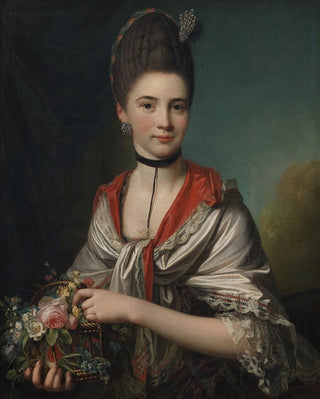Art print | Portrait of Anna Elisabeth Battier née Storp - Jens Juel Source: Reproduction | Portrait d'Anna Elisabeth Battier née Storp - Jens Juel


View from behind

Frame (optional)
The "Art print of Anna Elisabeth Battier née Storp" by Jens Juel is a work that transcends mere representation. This painting, created in the heart of the 18th century, embodies the very essence of Danish bourgeoisie of the time. Through the gaze of this woman, the artist manages to capture not only her physical appearance but also the aura of sophistication and dignity that surrounds her. The soft light and play of shadows on her face testify to an exceptional skill, inviting the viewer to ponder her story and character. Contemplating this piece transports us to a world where every detail matters, where each brushstroke tells a story.
Style and uniqueness of the work
Jens Juel's style is distinguished by its realism and ability to capture the soul of his subjects. In this portrait, Anna Elisabeth Battier appears dressed in an elegant gown, adorned with refined details that reflect her high social status. The color palette chosen by Juel, blending warm tones and delicate shades, creates an intimate and warm atmosphere. The features of Anna's face, carefully detailed, reveal rare psychological depth, while her gaze, both gentle and penetrating, seems to invite the viewer into a silent conversation. This work is not just a representation; it becomes a true dialogue between the artist, the subject, and the audience, an interaction that endures through the centuries.
The artist and his influence
Jens Juel, an emblematic figure of Danish painting, knew how to mark his era with his innovative approach to portraiture. Trained at the Royal Danish Academy of Fine Arts in Copenhagen, he was influenced by the great European masters but developed a style that is uniquely his own. His work is characterized by meticulous attention to detail and a deep understanding of human emotions. Juel also played a key role in promoting portraiture as an artistic genre in Scandinavia, inspiring many artists to follow in his footsteps. His legacy endures, and the "Art print of Anna Elisabeth Battier née Storp" is a shining testament, reminding

Matte finish

View from behind

Frame (optional)
The "Art print of Anna Elisabeth Battier née Storp" by Jens Juel is a work that transcends mere representation. This painting, created in the heart of the 18th century, embodies the very essence of Danish bourgeoisie of the time. Through the gaze of this woman, the artist manages to capture not only her physical appearance but also the aura of sophistication and dignity that surrounds her. The soft light and play of shadows on her face testify to an exceptional skill, inviting the viewer to ponder her story and character. Contemplating this piece transports us to a world where every detail matters, where each brushstroke tells a story.
Style and uniqueness of the work
Jens Juel's style is distinguished by its realism and ability to capture the soul of his subjects. In this portrait, Anna Elisabeth Battier appears dressed in an elegant gown, adorned with refined details that reflect her high social status. The color palette chosen by Juel, blending warm tones and delicate shades, creates an intimate and warm atmosphere. The features of Anna's face, carefully detailed, reveal rare psychological depth, while her gaze, both gentle and penetrating, seems to invite the viewer into a silent conversation. This work is not just a representation; it becomes a true dialogue between the artist, the subject, and the audience, an interaction that endures through the centuries.
The artist and his influence
Jens Juel, an emblematic figure of Danish painting, knew how to mark his era with his innovative approach to portraiture. Trained at the Royal Danish Academy of Fine Arts in Copenhagen, he was influenced by the great European masters but developed a style that is uniquely his own. His work is characterized by meticulous attention to detail and a deep understanding of human emotions. Juel also played a key role in promoting portraiture as an artistic genre in Scandinavia, inspiring many artists to follow in his footsteps. His legacy endures, and the "Art print of Anna Elisabeth Battier née Storp" is a shining testament, reminding






